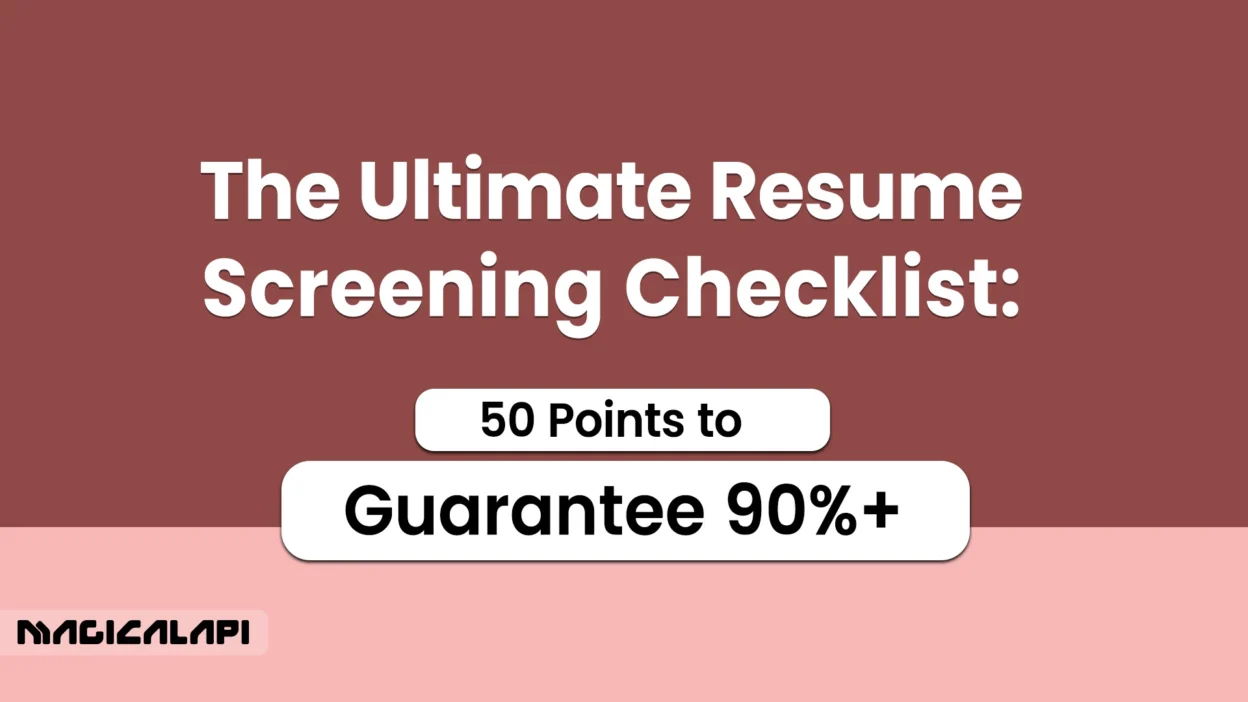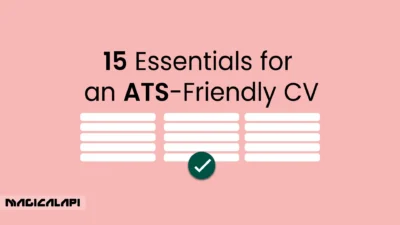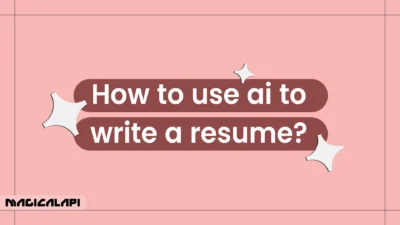In the current recruitment climate, speed is critical, but the need to find the right candidate, a person with the right skills and equal if not better cultural fit than their competency, is never more important. So the question is, how can you use a solid resume screening checklist to take the heat off your search for talent?
This resume screening checklist is more than an overview of keywords, and this complete 50-point guide will help you standardize your evaluation and reduce bias so that you an consistently identify higher-quality talent and increase your accuracy above 90%.
Think of it as a quality-control checklist to review your resume for hiring. Just as engineers use cv screening checklists to maintain precision, recruiters can use this framework to improve outcomes while saving time. With the right approach, you won’t just fill positions quickly, you’ll build stronger, more resilient teams.
Table of Contents
Understanding the Purpose of a Resume Screening Checklist
A resume screening checklist is not merely a to-do list; it is a strategic plan that helps ensure consistency and fairness in evaluating any given candidate against the essential requirements of the roles you are hiring for. What Is a Resume? It provides a plan for a potentially subjective process with the possibility of unconscious bias. Using a cv screening checklist creates efficiency, saves time, and ultimately allow you to make better data-based decisions about which candidates you think should to the next stage.
Essential Sections Every Checklist Should Include
Before you begin analyzing the details, it is important to organize your analysis. A checklist to review your resume that meets the fundamental components of a resume will allow you to understand the essential information and not miss key information. These main sections make up the key parts of your resume screening tips and taken together, provide a complete review of the applicant.
Structuring Your Evaluation: Key Resume Components
An efficient screening process requires a logical path to follow. We encourage you to breakdown your cv screening checklist by subject area per standard resume. This will help you to systematically review each applicant’s qualifications and experience.
Contact Information and Professional Presentation
This section is a simple but essential effort to determine professionalism and ease of contact information. It creates the first impression and will allow you to contact good candidates without any issues. resume screening tips:
1. Clarity and Completeness
Is the applicant’s name, phone number, and professional email visible and easy to find? This basic information should be easy to see, typically at the top of the resume. If you have to search for it, they haven’t produced a good product for you to use which suggests they may not have considered your experience and usability as a recruiter. Having complete information on the document is an indication of thoroughness and a serious applicant.
2. Professional Email Address
Does the applicant have a professional email address (e.g., [email protected])? We have come across poor example email addresses of people who likely take themselves seriously, such as [email protected]. It will demonstrate a lack of professional maturity or attention to detail. It is a minor issue, but it adequately demonstrates their judgment and also how they present themselves in a professional context.
See real‑world examples—tap here to upgrade your resume for internship from basic to brilliant.
3. LinkedIn Profile URL – Resume Screening Checklist
Does the resume include a link to a complete and professional LinkedIn profile? A quality LinkedIn profile can confirm the resume’s information, and gives the reviewer a clearer and more complete perspective of the candidate. The profile should be up to date, includes a professional photo, has a detailed professional summary, and has endorsements of their proclaimed skills, which demonstrates professionalism and engagement in their professional community.
4. Portfolio/website (if appropriate)
Have they included a portfolio or personal website for the applicable roles (design, writing, development)? The resume is less significant (or sometimes secondary) than the actual portfolio for creative and technical roles. The portfolio is where you can see their skills in action. Not providing one for a role that expects it is a big red flag.
Matching Candidate Qualifications to Job Requirements

This is the core of your evaluation. It’s where you meticulously align the candidate’s background with the specific needs of the position.
5. Must-Have Qualifications – Resume Screening Checklist
Does the candidate have all the critical, non-negotiable qualifications? Before you even post a job, you need to have a definition of “must-have” qualifications and “nice-to-have” qualifications. This is your first and most significant filter. If the candidate does not have a non-negotiable skill or qualification, it is much more likely they are not a candidate, and it directly saves you time and effort.
6. Experience in a Similar Role
Has the candidate been in roles with similar responsibilities? Look for job titles and job descriptions that are similar to the role you’re hiring for. This will be an indication that the candidate can likely perform the duties of the role in much less time. This candidate will look at the challenges and expectations of the role from day one.
7. Industry Experience – Resume Screening Checklist
Does the applicant have experience in your industry or a similar one? Industry experience means the candidate will have existing familiarity with the market, competitors, customer base, and regulations. There is a real benefit to inside knowledge and having this piece will shorten the learning curve dramatically.
8. Job Posting Keywords
Does the resume contain keywords and phrases taken from the job posting in a natural way? Many organizational hiring processes and many companies utilize an Applicant Tracking System (ATS), and a powerful Resume Parser within it that have this check as part of the software. It is important, however, to still complete this manually to ensure it is presented as part of their accomplishments, rather than just a list of keywords.
Magical Resume Parser
Discover the powerful capabilities of the Magical Resume Parser and explore the various options available to streamline your hiring process, optimize candidate selection, and enhance recruitment efficiency.
Verifying Technical Skills and Industry Tools
In a technology-centric world, verifying a candidate’s technical acumen is non-negotiable for many roles. What features should I look for in a resume screening tool?
9. Software Proficiency
Does your candidate have a software proficiency listed? Each position will require its own software (Salesforce, Adobe Creative Suite, JIRA, etc.). However, it is not enough to simply list software proficiency. It requires context. How did they use the software? Did they leverage it for anything measurable? This suggests application rather than just learned experience.
10. Programming Languages/Frameworks (for technical roles)
Do they have the required programming languages/frameworks listed? (Python, Java, React, etc.) Opposed to overall qualifications and experience, if you are looking for a technical position, this is the foundational requirement. The best resumes will not only list programming languages but might rank their level of proficiency or include a link to their GitHub repository to view their coding work.
11. Technical Certifications – Resume Screening Checklist
Does the applicant have the appropriate technical certifications? (AWS Certified Developer, Google Analytics IQ, etc.) Certifications represent either an extra piece of proof in the evaluation of an applicant’s skill levels and rely on a third-party to validate claims. Additionally, they suggest dedication to professional development and indicate a proven level of proficiency under a specific technology or platform.
12. Familiarity with Industry-specific Tools
Is there any indication of experience with tools unique to your industry? Every industry has its specialized software and tools. A candidate who is already familiar with the tools will require less training and will be able to quickly immerse themselves into the workflow of your team. A good sign they are an insider to the industry.
Evaluating Soft Skills and Cultural Fit Indicators
Soft skills (also referred to as human skills) are the relational qualities that describe how a candidate will work and relate to others, and may be the distinguishing characteristics that separate equally qualified candidates.
13. Communication Skills
The resume is a good reflection of the candidate’s writing communication skills, is the resume well-written and to the point? If there is a lot of jargon and overly complex sentences and vague descriptions in the resume, then perhaps this is a reflection of the candidates’ workplace communication. Clarity and conciseness are critical.
14. Problem-Solving – Resume Screening Checklist
Does the candidate describe situations that were difficult and the steps taken to resolve those situations? Look for descriptions of situations that follow the STAR process (Situation, Task, Action, Result). The use of terms like “resolved”, “optimized”, or “streamlined” tend to indicate strong problem-solving skills.
15. Teamwork and Collaboration
Is there mention of team projects, cross-functional collaborations, or leading teams? Most work environments are highly collaborative in nature, Is there information about partnering, collaborating, or working together? They should show an ability to work effectively in unison with others in a larger organizational unit.
16. Leadership Experience
Look for signs of mentoring, leading projects, or supervisory experience. Remember, leadership does not just mean people management. Leading a project, training a new employee, or taking initiative to organize a new process could also show leadership. All valuable experiences, even if the candidate is not applying for a people management role.
17. Adaptability – Resume Screening Checklist
Does their career trajectory display a willingness to engage in learning new skills or take on a variety of responsibilities? A candidate that can demonstrate success in a variety of roles, industries, or sizes of organizations is likely demonstrating adaptability and resilience. Look for career progression into positions that required taking on new learning, or that were outside of the candidates norm or comfort zone.
18. Connection to company values
Does their tone and articulation of their experience align with your organization’s values (e.g., innovation, client focus)? If teamwork is a value of your organization, a resume that only describes individual achievements could indicate a potential mismatch. The way a resume is developed can give clues as to what is important to the candidate.
Confirming Education, Certifications, and Licenses
This section validates the foundational credentials required for many professional roles.
19. Required Credential/Level of Education
Does the candidate hold the minimum required credentials? Usually, this is a straightforward check. If the position requires a certain degree as a legal or regulatory requirement, that is not negotiable. If it does not require a certain degree, consider if the candidate’s work experience provides an equivalent to formal education.
20. Reputable School
Is the school accredited and recognized? Discrimination based on reputation should not happen; however, if you have never heard of them, it is worth checking that it is an accredited institution.
21. Related Education/Major
Is their educational field of study related to the position? An applicant’s major and possibly specific coursework can give you an early indication of their knowledge of your industry if they are a recent college graduate. This becomes less important for an experienced employee.
22. Non-technical Certifications
Are there non-technical certifications listed? (i.e., PMP, SHRM-CP) Non-technical certifications, like technical certifications, help verify their knowledge in areas such as project management, human resource, and finance. Non-technical certifications demonstrate a commitment to their profession.
23. Current Licenses
If a license is needed for a position (e.g., CPA, RN), is it a valid and current license? For many professions, these predominantly in healthcare, finance, or law, a current and valid license is an absolute must in order to proceed with the position. As a reminder, always indicate if the license is active on resume.
Spotting Red Flags in Employment History
A candidate’s career path tells a story. Look for potential issues that might signal instability, lack of focus, or other concerns.
24. Unexplained Gaps in Employment
Are there a lot of sizable gaps in time? Gaps in experience are not inherently a bad thing—people take time off to spend time with family, pursue education, or to travel. However, a resume should at least do its best to address the gaps. If a gap is left unexplained, it creates opportunity to probe on a phone screen.
25. Job Hopping – Resume Screening Checklist
Does the candidate have a history of job hopping and working at companies for less than a year? Yes, long histories of working at companies for less than a year can be red flags. It may show an inability to commit, performance issues, or a bad fit in the company culture in the previous jobs.
26. Inconsistent Career Path
Does their professional progression lack a focus or clear direction? If a resume is hopping around, with no narrative about changing professions or summers with a relevant industry job, it could mean that that individual does not have a firm direction or career goals. You don’t want to hire someone who is merely intentionally pursuing a job in this career.
27. Job Descriptions are Vague or Ambiguous
Are responsibilities and accomplishments described in general terms, and without any detail? Weak examples would include terms like “responsible for…”, or “duties included…” Strong candidates will describe their impact and accomplishments. Sometimes, vagueness can be a sign of a candidate who has not made any meaningful contributions.
28. Employment Dates are Overlapping
Are there overlapping employment dates without explanation? This sometimes occurs due to merely a typographical error, but it may also occur because a candidate is hiding a short tenure with a job, or gap in employment. Either way, questionable dates are likely worth a double check, and a clarifying question.
Highlighting Achievements and Quantifiable Results
The difference between a good resume and a great one often lies in the presentation of achievements. Great candidates show, they don’t just tell.
29. Action Verbs
Does the resume use active and strong action verbs such as “developed,” “led,” “managed,” “gained,” or “negotiated?” Action verbs are more helpful than passive phrases because they convey ownership and impact.
30. Metrics for resume screening checklist
Can they quantify their achievements by providing numbers and data? For example, “Grew sales by 15%,” “Was able to reduce costs by $10K” This is one of the most important areas examine and consider. Numbers provide hard evidence and value to a candidate. A high Resume Score will almost always correlate with quantitative results.
Magical Resume Score
Discover everything you need to know about Magical Resume Score , how it evaluates your resume, and the various options available to enhance your job application and improve your chances of success.
31. Awards in resume screening checklist
Did the candidate obtain any professional awards or accolades? Awards such as “Salesperson of the Year” or the “President’s Club” are evident indicators of not only performance, but recognition by their employers.
32. Promotions – Resume Screening Checklist
Does it look like the candidate has achieved promotions, but also increased responsibility throughout their work history? If the candidate was promoted in the past to more responsibility it may send the clear message they proved value and their employer trusted their ability.
Ensuring Clarity, Formatting, and Readability Standards
The presentation of the resume is a direct reflection of the candidate’s professionalism and attention to detail.
33. Professional and Clean Layout
Is your resume easy to read and aesthetically pleasing? A resume that is crowded, messy, or overly decorative can be difficult to read. A clean layout with adequate white space respects the recruiter’s time and makes it easy for them to locate the information they need at a glance.
34. Consistent Formatting
Are fonts, font sizes, and date formats consistently presented? Inconsistency can look sloppy and suggests carelessness. Consistent formatting in these particulars may suggest you are detail-oriented, a valuable asset to any employer.
35. Appropriate Length
Is the resume only as long as it needs to be (ideally 1-2 pages for most professionals)? One page is typical for the early career professional and two pages is acceptable for the more experienced professional. A resume longer than two pages is typically excessive and suggests poor editing, verbage, or laziness.
36. Correct Grammar and Spelling
Does the document contain any typos or grammatical errors? In this day and age, there is no excuse for spelling errors. It is often one of the first things that a hiring manager will recognize. The people that are serious about their job search will run a Resume checker before applying.
Magical Resume Checker
Discover the full potential of the Magical Resume Checker and explore the various options available to enhance your resume, optimize it for applicant tracking systems (ATS), and improve your chances of landing your dream job.
37. Clear Section Headings
Are the sections of the resume clearly separated? Having standard headings like “Work Experience,” “Education,” and “Skills,” makes for easy navigation. You do not have to waste time searching for the information you need to make a decision.
Detecting Resume Fraud or Misrepresentation
Trust but verify. While most candidates are honest, being vigilant for inconsistencies can save you from a bad hire.
38. LinkedIn Profile Alignment
Are the job titles, dates, and roles on the resume in alignment with their LinkedIn profile? This is probably one of the easiest, yet impactful checks you can do. Any differences will be a significant red flag that they will have to explain.
39. Inflated Job Titles in resume screening checklist
Are the job titles being inflated for the job duties? If a candidate lists themselves as a “Director of Marketing” and their actual job duties sound like those of a Marketing Coordinator then they are likely intending to inflate their experience.
40. Ambiguous or Impossible to Verify
Are there any statements that would be difficult or impossible to verify? Be careful of any statements that are ambiguous or grandiose that are not supported with details or metrics. Any thorough resume evaluation checklist should make you question such statements!
Promoting Diversity and Inclusion During Screening
An equitable screening process is also an effective screening process. You will want to actively remove bias and create an equitable opportunity for applicants.
41. Focus on Skills and Qualifications
Intentionally remove bias-inducing information (e.g. name, age, gender, address). You will need to train yourself and your team to think solely about whether or not the candidate can perform the job. This is the fundamental principle of unbiased hiring.
42. Utilize a Blind Screening Process
Consider using software that anonymizes resumes and decreases conscious bias. Some Applicant Tracking Systems (ATS) offer features that can hide all identifying information related to applicants as part of a screening process. This will force reviewers to consider the merit of the candidates and their qualifications.
43. Inclusive Language in resume screening checklist
Do not penalize applicants for using different but equivalently words to demonstrate their skills. For example, a candidate may have written “stakeholder management” instead of “client relations.” These are equivalent skills.
44. Non-Traditional Backgrounds
Be open to all backgrounds and career paths in your consideration of candidates. A candidate that is self-taught or from a different industry may provide valuable insight and skills that a candidate with traditional experience may not possess.
Utilizing a Resume Screening Checklist Excel Template
For a tactile and customizable tool, a spreadsheet can be your best friend.
45. Flexible Criteria
You can easily choose and/or subtract items from the checklist according to the role. A resume screening checklist excel template is not a one-size-fits-all solution. You can adapt it, and you ranked the criteria by most important to hire for a different position you are hiring for.
46. Scoring System in resume screening checklist
You can assign point values to different criteria, assigning a numerical ranking to applicants. This will help you make the process more objective. Once you have scored checklist items, you can then compare applicants against a standardized scoring sheet, helping you provide rationalization for your decisions.
47. Collaborative Review
You have the ability to share your Excel file with your hiring team to receive input and make comments. Sharing a checklist will ensure that everyone on the hiring panel is assessing applicants based on exactly the same criteria, and allows for greater consistency in outcomes among applicants.
48. Data Tracking and Reflection
You can use the data from your Excel checklists to reflect on your hiring processes, and identify trends in their iterations. You will be able to determine which criteria are better than others in predicting success in a role, and modify your cv screening checklists and job descriptions for other positions in the future.
Summarizing Findings and Recommending Next Steps
The final stage of screening is to synthesize your evaluation into a clear and actionable recommendation.
49. General assessment
Drawing on the resume screening checklist, develop a short general assessment of the candidates’ strengths and weaknesses. Your general assessment should be an evidence-based snapshot of why the candidate is or is not qualified. It is the basis for your recommendation.
50. Clear recommendation
Your recommendation should speak to whether to progress the candidate to the next stage of the process (e.g., phone screen, interview), or to keep their resume on file for future possibilities. This should be a very clear yes, no, or maybe. To summarize candidates at a high level, the Best Ats Resume Checker can produce a high-level score that can be used to categorize candidates easily.
In summary: a more strategic hire for resume screening checklist
By executing this guide that covers 50 point cv screening checklist for resume screening, you are not just scoring, you are creating a more strategic, fluid, and fair process for recruitment. A resume screening checklist, used in a coordinated way, will help you find candidates who are not only qualified on paper, but potential valuable assets to the individual you work for in the future.
Common Questions about Resume Screening Checklist
1. How can a screening checklist for resumes enhance the quality of hiring?
A resume screening checklist enhance the quality of hiring by enabling an objective and thorough evaluation of each candidate, focusing on the specific requirements for the position. This way there is no bias in the decision process that could lead to overlooking possible candidates or moving forward with poor candidates, meaning that there is a strong talent pool at the interview stage.
2. What are the most important red flags to look for in resumes?
The key red flags include unexplained gaps in employment; candidates who seem to have a history of ‘job hopping’; major inconsistencies between the resume and LinkedIn profile; nothing quantifiable in previous job achievements. All of these can indicate lack of stability, no direction or legitimacy.
3. How can I ensure my resume screening process is fair and unbiased?
To ensure fairing, rely on the skills, experience and qualifications outlined in your job description. Use blind screening whenever possible even up to taking names and photos off resumes. Educate your hiring team on unconscious bias.





